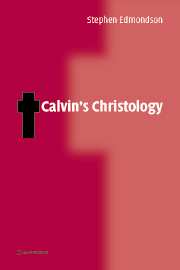6 - The person of the Mediator
Published online by Cambridge University Press: 22 September 2009
Summary
Jesus said: “You believe in God, believe also in me” (John 14:1). It is “wonderful,” Calvin comments, that Christ would place faith in the Father before faith in himself, against the expected logic. Since Christ is the lively image of the Father who has descended to us that we may ascend to the Father, he continues, it would have made more sense if Christ had argued that the disciples “ought to believe in God since they had believed in Christ.” We come to God having begun with Christ. But Christ was pushing toward a different conclusion:
For all acknowledge that we ought to believe in God, and this is an admitted principle to which all assent without contradiction; and yet there is scarce one in a hundred who actually believes it, not only because the naked majesty of God is at too great a distance from us, but also because Satan interposes clouds of every description to hinder us from contemplating God. The consequence is, that our faith, seeking God in his heavenly glory and inaccessible light, vanishes away.
Christ begins his final instructions to his disciples in John's Gospel in the same place that Calvin began his Institutes, with the sense inherent in all persons that we are called to faith in God, but that we are cut off from God both by our finitude and by the barriers that Satan can erect because of sin.
- Type
- Chapter
- Information
- Calvin's Christology , pp. 182 - 219Publisher: Cambridge University PressPrint publication year: 2004



